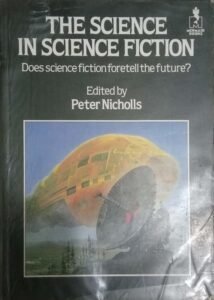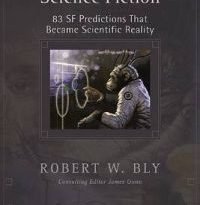The Science In Science Fiction edited by Peter Nichols (book review).
The name ‘Peter Nichols’ should flash a recognition in your heads if you had the UK’s ‘Encyclopaedia Of Science Fiction’ and found it a useful book, even today, as he was its editor. This book, ‘The Science In Science Fiction’, has Nichols together with Brian Stableford and David Langford looking at just that. Each author contributes to a number of chapters providing the subject coverage totalling twelve in all, but you would be hard put to recognise them individually without notes in the introduction, so forgive me for using the collective ‘they’.
Nichols is keen to point out in the introduction that SF authors can’t predict the future as there’s too much diversity, but they are often ahead of actual inventions from time to time. Something that is somewhat lacking today. They answer the subtitle, ‘Does Science Fiction Foretell The Future’, quickly but only in the sense of events rather than anything else. Based purely on Philip K. Dick’s ‘Do Androids Dream of Electric Sheep?’—which was filmed as ‘Blade Runner’—we should, by rights, be out among the stars by now.
Although this book came out 47 years ago, it is still relevant today, especially regarding science. Take the opening chapter on space travel. The issues surrounding interstellar flight remain pertinent, with the only potential changes being in the SF examples. The problem with the Internet is that it provides bits of information, which often leads to skimming instead of thoroughly reading about the subject. If you’re planning to write science fiction, then you really need to see the subject in depth. Not too much depth to get bogged down, but to put the information in context as to the choice options, like trying to get close to the speed of light against a generation ship to get to the nearest star. The choices haven’t really changed over the years.
The chapter on power sources turned out to be a retrospective on past predictions about future developments. Yes, wind was discussed, but there was a lot more emphasis on tidal power. Back in the day, there was less assessment of potential damage to the environment. Although there is some tidal collection today, it does explain why wind farms are less dangerous to marine life. Many of the issues stem from the placement of energy infrastructure. There isn’t any emphasis on energy storage, largely because practical limits have existed both in the past and present. Interestingly, the issues surrounding nuclear fission have remained largely unchanged. In many respects, as energy users, we don’t really use it efficiently enough. The authors sometimes point to our future, around the turn of the century, so you can compare. As they say, they can’t predict the future, but it’s not far off.
Something poignant under chemical warfare did stop and make me think. They argue that the lack of its use in SF stems from its real-world application. Despite the fact that many SF elements mirror our reality, their use persists.
As the book title suggests, they compare our reality to how closely it is mirrored in science fiction, and the associated problems are probably unlikely to happen. The last three chapters point out how far SF authors go in the wrong direction. In many respects, the problem is now deemed the ‘fudge factor’ and used to get the plot to move along, usually giving some brief explanation for the reader to follow if needed. As such, we tend to find faster-than-light travel, time travel, and such acceptable because they are used more often than practical problems. We understand that it is a work of fiction, otherwise it would not fall under the category of science fiction.
Oddly, there are very few mistakes, and these tend to be with SF rather than science. On page 131, there is the untitled cover of ‘High Crystal’, the third ‘Cyborg’ novel by Martin Caiden, describing him as a robot when it’s obvious that it’s the cyborg, Steve Austin, and he would need to wear a watch. It isn’t as though Austin isn’t covered a little under the subject of cyborgs further on. On page 133, they refer to the Cybermen from ‘Doctor Who’ as robots, despite their actual status as cyborgs with organic brains. They describe the Millennium Falcon as travelling through hyperspace and ignore the fact that the other space vessels in ‘Star Wars’ must use the same route.
I still think this is an important book. This book not only elucidates the truths of science in contrast to science fiction, but also provides numerous illustrations that enhance its retention in your memory. You don’t have to be a rocket scientist to understand all of it, but you will have a keener idea of the problems of coming up with something new, let alone reusing old ideas with a different interpretation.
Although there have been a few non-fiction books following this book’s path afterwards, I’m less impressed by them compared to this book now that I’ve read it. The examples provided in these books are drawn from science fiction up to this point, and I have compiled nearly two pages of book titles and a few films to explore, which is an added bonus.
Even better, you can still get decent copies out there at a reasonable price.
GF Willmetts
May 2025
(pub: Mermaid Books/Michael Joseph, 1982. 208 page illustrated indexed large softcover. Price: varies. ISBN: 0-7181-2300-X)




